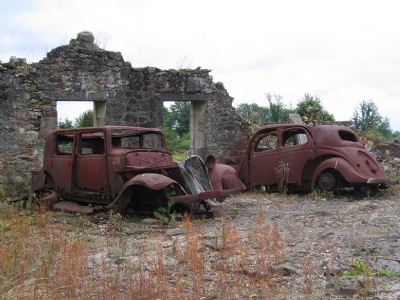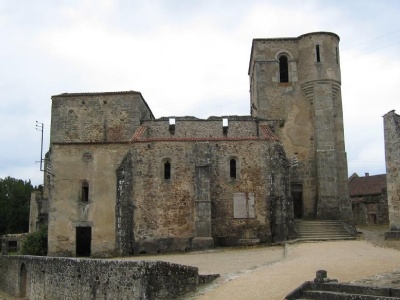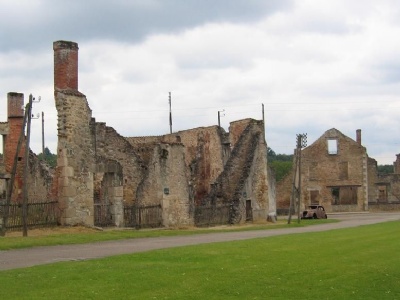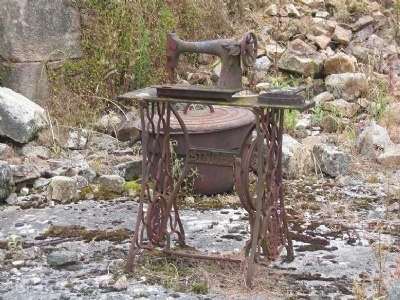Oradour-sur-Glane
On June 6, 1944, the western allies landed on the beaches of Normandy. The Landing had been preceded by intense activity from the French resistance movement (Maquis). Their main contribution was to provide the allies with information about the location, movements and strength of German troops. It also carried out sabotage that made it more difficult for the German troops to enter Normandy, but it rarely took part in any direct fightings with Germans. SS Pansardivision Das Reich was located in the south of France and received late orders to move north towards Normandy.
On the way up to Normandy, Das Reich, passed through Oradour-sur-Glane and there, on June 9, SS-Sturmbannführer Helmuth Kämpfe was captured by the French resistance movement. Kämpfe was the highest in rank that was captured by the resistance movement. Informants among the locals informed the Germans where Kämpfe was being held captive and that he would be executed the next day in a small village called Oradour-sur-Vayres. The SD in Limoges confirmed this and the village was also suspected to house members of Maquis.
The next day, June 10, the commander of the 1st battalion of Der Führer armored panzer grenadier regiment, SS-Sturmbannführer Adolf Diekmann, was ordered by his superior, SS-Standartenführer Sylvester Stadler, to enter Oradour-sur-Vayres and order the village mayor to select 30 people to be hold as hostage in exchange for Kämpfe. Diekmann confused Oradour-sur-Vayres with Oradour-sur-Glane and his battalion surrounded the village and ordered all the inhabitants to gather at the central assembly point under the pretext of checking their identities. Once there, Diekmann made his own orders and ordered the women and children to be locked up in the church, which was then set on fire.
The men were sent to six prepared places in the village where they were shot. At the same time as the massacre was going on, the village was looted and destroyed. The Germans also placed an explosive device in the church to be sure that all died. A total of 642 people were murdered, 205 children, 247 women and 190 men, only five men and one woman survived the massacre. The woman managed to escape through a window in the church and stayed hidden until the Germans left the village. Another 20 people fled the village just before the Germans arrived. The majority of the battalion that participated in the massacre were later killed in battle and Diekmann himself died a few weeks later in the fighting in Normandy. He is buried in the German war cemetery of La Cambe in Normandy.
Current status: Demolished with museum (2007).
Location: 45°55'43.86" N 01°02'26.32" E
Get there: Car.
Follow up in books: Fouche, Jean-Jaques: Massacre At Oradour, France, 1944 (2005).





The Museum is called Centre de la Memoire and opened in 1999. The focus is, of course, on the massacre in Oradour and the visitor gets to follow Das Reich and the residents until the fateful day. But what is interesting is that through the museum you get into what was once Oradour-sur-Glane. After the war, French President Charles de Gaulle decided that the ruins of the village would be preserved for posterity as proof of the Nazi crimes. In 1999, former president Jacques Chirac, inaugurated the museum and declared the village a martyr’s village (Village martyr).
All the ruins are more or less left as they were that fateful day. Houses in poor condition have been supported by beams to be preserved for posterity. Among the ruins are personal items such as bicycles, sewing machines, pots, wrecks and agricultural machines that have remained in the garage since that day. The tram tracks and electric posts are also preserved and in the cafes the ruined chairs and tables remain. In the bakery are the remains of the baking oven. The ruins may not be entered with the exception of the destroyed church. It was there that the women and children were burned alive.
One can still see the marks of the shooting in the church walls when the SS opened fire straight into the church against people who tried to escape the flames. At the altar are the remains of a small toy stroller that once probably belonged to a little girl. The roof of the church is gone because the SS tried to blow up the whole building. In the church there is also a memorial to the people who lived in Oradour and died in the First World War. The Church painting collapsed during the massacre but was recovered and now hangs there with two bullet holes as a reminder. Just outside the village is the cemetery where several of those who died during the massacre are buried.
Village martyr is extremely interesting to wander around because it gives a good overview of what the village once looked like. All the objects I just mentioned give a personal touch of the village. There are lots of personal belongings at the exhibitions in, for example, Auschwitz, but there the personal belongings tend to disappear among the hundreds of other objects located in the same stand. We all have a cafe, post office, bakery, church, school, house, car that we can relate to. Therefore, Oradour becomes more tangible and personal and makes it easy for the visitor to identify with the victims in a way that cannot be done in Auschwitz. Oradour is one of the most interesting sites I have visited.